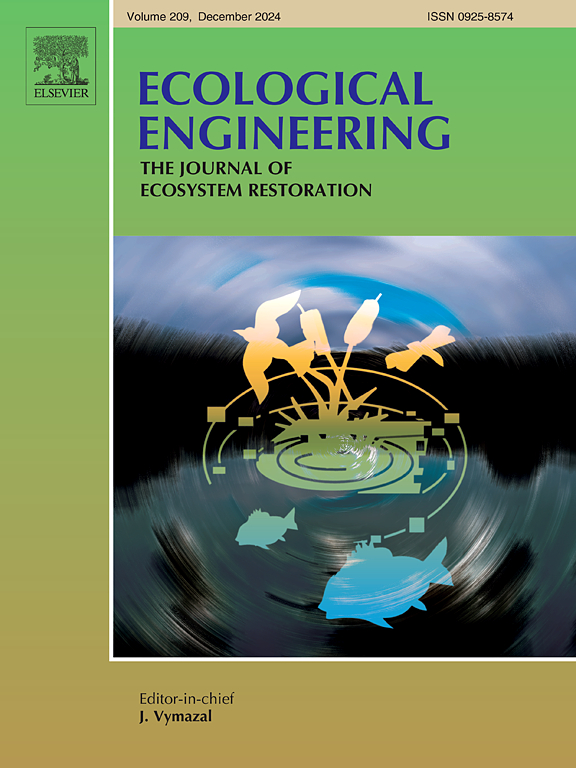More than the sum of their parts — Environmental flows increase fish movement and fishway functionality
IF 3.9
2区 环境科学与生态学
Q1 ECOLOGY
引用次数: 0
Abstract
The ecology of riverine fish is intrinsically linked to attributes of the natural flow regime such as duration, timing, and magnitude. The flow regimes and hydrological connectivity of many rivers globally has, however, been severely altered by river regulation, detrimentally impacting fish populations. Environmental flows and fishways are increasingly being used to reinstate important aspects of the flow regime, improve instream connectivity, and recover fish populations. The present work examines the potential benefits that the combination of fishways and environmental flows may have in terms of greater overall environmental outcomes than fishways alone.
We used multiple lines of evidence to correlate fish movement through multiple fishways in three lowland Australian rivers with increases in discharge mainly driven by environmental flows. Specifically, fish movement rates (from PIT tagged fish and fishway trapping) were modelled against stream discharge and water temperature, while the internal hydraulics (turbulence, water velocity and discharge) of a low level (<3 m head) fishway was modelled over three different flow scenarios — low, medium, and high discharge — to document functional changes that improved fishway efficiency with increased discharge.
Fishway trapping and PIT tag data indicated that native fish movement increased with increases in discharge associate largely with environmental flows, and medium-large magnitude flow events resulted in a greater movement response. Environmental flows raised river levels and improved the internal hydraulics of one low-level vertical-slot fishway, specifically benefiting passage of the smallest fish species and size-classes. Management interventions, such as environmental flows and fishways, come at considerable cost and require empirical data regarding their benefits, yet the potential benefits of combining interventions is rarely quantified against key objectives. This study presents evidence demonstrating that environmental flows cue fish migration and improve fishway efficiency and thus promote functional fish populations.
不仅仅是它们各部分的总和——环境流动增加了鱼的运动和鱼道的功能
河流鱼类的生态学本质上与自然流动状态的属性有关,如持续时间、时间和大小。然而,全球许多河流的水流状况和水文连通性已经被河流调节严重改变,对鱼类种群产生了不利影响。环境流和鱼道越来越多地被用于恢复流态的重要方面,改善溪流连通性,恢复鱼类种群。目前的工作考察了鱼道和环境流的结合可能比单独的鱼道具有更大的整体环境结果的潜在利益。我们使用了多条证据,将三条澳大利亚低地河流中通过多条鱼道的鱼类运动与主要由环境流量驱动的排放量增加联系起来。具体来说,鱼的运动速率(来自PIT标记的鱼和鱼道捕获)根据水流流量和水温进行了建模,而低水位(3米水头)鱼道的内部水力学(湍流、水流速度和流量)在三种不同的流量情景下进行了建模——低、中、高流量——以记录随着流量增加而提高鱼道效率的功能变化。鱼道捕获和PIT标签数据表明,本地鱼类的运动随着流量的增加而增加,这在很大程度上与环境流量有关,中大型流量事件导致了更大的运动响应。环境流动提高了河流水位,改善了一个低水平垂直槽鱼道的内部水力学,特别有利于最小的鱼类品种和尺寸等级的通过。管理干预措施,如环境流量和鱼道,成本相当高,需要有关其效益的经验数据,但结合干预措施的潜在效益很少针对关键目标进行量化。本研究提出的证据表明,环境流动提示鱼类洄游,提高鱼道效率,从而促进功能鱼类种群。
本文章由计算机程序翻译,如有差异,请以英文原文为准。
求助全文
约1分钟内获得全文
求助全文
来源期刊

Ecological Engineering
环境科学-工程:环境
CiteScore
8.00
自引率
5.30%
发文量
293
审稿时长
57 days
期刊介绍:
Ecological engineering has been defined as the design of ecosystems for the mutual benefit of humans and nature. The journal is meant for ecologists who, because of their research interests or occupation, are involved in designing, monitoring, or restoring ecosystems, and can serve as a bridge between ecologists and engineers.
Specific topics covered in the journal include: habitat reconstruction; ecotechnology; synthetic ecology; bioengineering; restoration ecology; ecology conservation; ecosystem rehabilitation; stream and river restoration; reclamation ecology; non-renewable resource conservation. Descriptions of specific applications of ecological engineering are acceptable only when situated within context of adding novelty to current research and emphasizing ecosystem restoration. We do not accept purely descriptive reports on ecosystem structures (such as vegetation surveys), purely physical assessment of materials that can be used for ecological restoration, small-model studies carried out in the laboratory or greenhouse with artificial (waste)water or crop studies, or case studies on conventional wastewater treatment and eutrophication that do not offer an ecosystem restoration approach within the paper.
 求助内容:
求助内容: 应助结果提醒方式:
应助结果提醒方式:


